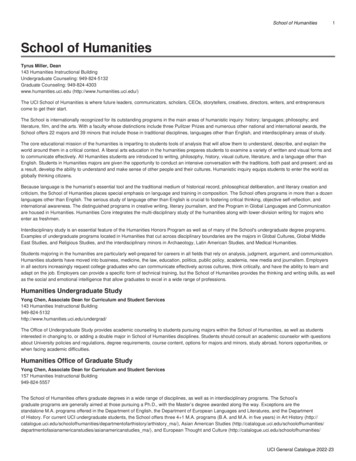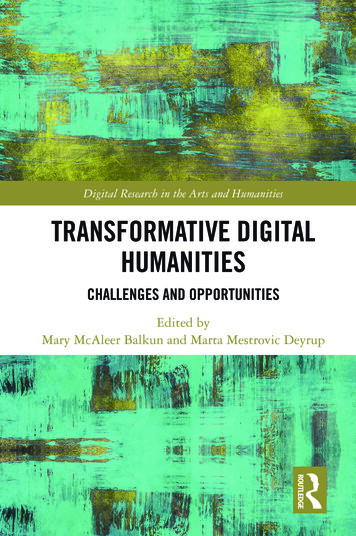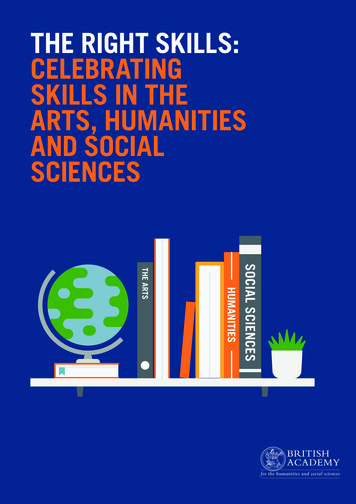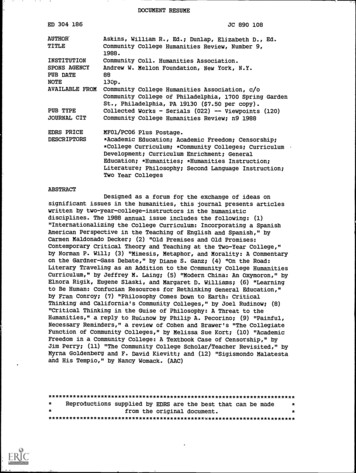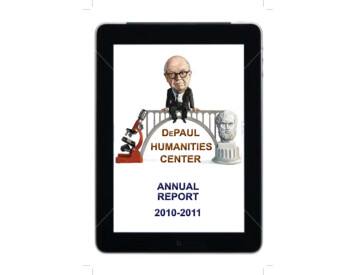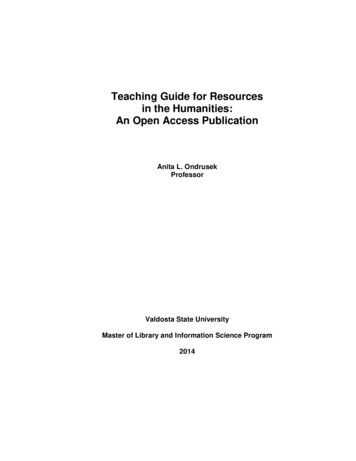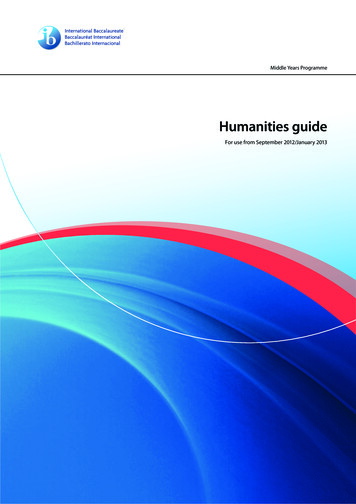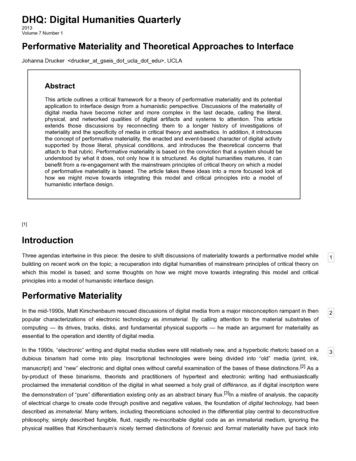
Transcription
DHQ: Digital Humanities Quarterly2013Volume 7 Number 1Performative Materiality and Theoretical Approaches to InterfaceJohanna Drucker drucker at gseis dot ucla dot edu , UCLAAbstractThis article outlines a critical framework for a theory of performative materiality and its potentialapplication to interface design from a humanistic perspective. Discussions of the materiality ofdigital media have become richer and more complex in the last decade, calling the literal,physical, and networked qualities of digital artifacts and systems to attention. This articleextends those discussions by reconnecting them to a longer history of investigations ofmateriality and the specificity of media in critical theory and aesthetics. In addition, it introducesthe concept of performative materiality, the enacted and event-based character of digital activitysupported by those literal, physical conditions, and introduces the theoretical concerns thatattach to that rubric. Performative materiality is based on the conviction that a system should beunderstood by what it does, not only how it is structured. As digital humanities matures, it canbenefit from a re-engagement with the mainstream principles of critical theory on which a modelof performative materiality is based. The article takes these ideas into a more focused look athow we might move towards integrating this model and critical principles into a model ofhumanistic interface design.[1]IntroductionThree agendas intertwine in this piece: the desire to shift discussions of materiality towards a performative model whilebuilding on recent work on the topic; a recuperation into digital humanities of mainstream principles of critical theory onwhich this model is based; and some thoughts on how we might move towards integrating this model and critical1principles into a model of humanistic interface design.Performative MaterialityIn the mid-1990s, Matt Kirschenbaum rescued discussions of digital media from a major misconception rampant in then2popular characterizations of electronic technology as immaterial. By calling attention to the material substrates ofcomputing — its drives, tracks, disks, and fundamental physical supports — he made an argument for materiality asessential to the operation and identity of digital media.In the 1990s, “electronic” writing and digital media studies were still relatively new, and a hyperbolic rhetoric based on adubious binarism had come into play. Inscriptional technologies were being divided into “old” media (print, ink,manuscript) and “new” electronic and digital ones without careful examination of the bases of these distinctions.[2] As aby-product of these binarisms, theorists and practitioners of hypertext and electronic writing had enthusiasticallyproclaimed the immaterial condition of the digital in what seemed a holy grail of différance, as if digital inscription werethe demonstration of “pure” differentiation existing only as an abstract binary flux.[3]In a misfire of analysis, the capacityof electrical charge to create code through positive and negative values, the foundation of digital technology, had beendescribed as immaterial. Many writers, including theoreticians schooled in the differential play central to deconstructivephilosophy, simply described fungible, fluid, rapidly re-inscribable digital code as an immaterial medium, ignoring thephysical realities that Kirschenbaum’s nicely termed distinctions of forensic and formal materiality have put back into3
play [Paul 2007].Not only are digital formats material, they are persistently and fundamentally so, as summed up in Kirschenbaum’s4phrase, “Every contact leaves a trace.” Kirschenbaum’s argument is organized around two aspects of materiality,forensic and formal. These are useful categories, and though they do not exhaust the discussion of material featuresand properties, summarizing his terms is a good place to begin. In Kirschenbaum’s definitions, forensic materiality refersto evidence, while formal materiality refers to the codes and structures of human expression. The forensic elements of adocument might include ink, paper, stains, fingerprints, other physical traces, while the formal elements would be theorganization of the layout, design, or the style of literary composition, relations between image and text and so on. Bothare available to description and analysis; neither is self-evident, each would have to be interpreted and placed in acontinuum of other evidence or read in relation to other texts, images, documents and the cultural codes of theircomposition. This distinction is excellent as far as it goes, and useful for reminding us that digital media have thesebasic dimensions. But his description is grounded in ontology rather than performance, in a sense that the identity ofmaterial things resides in their properties and capacities, in what they are rather than what they do. My emphasis on theperformative dimension of materiality is meant to extend, rather than replace, this understanding. Performativemateriality suggests that what something is has to be understood in terms of what it does, how it works within machinic,systemic, and cultural domains.The history of approaches to materiality is long and complex, with basic discussions of matter and form, substance andessence, traceable to earliest antiquity in many strains of philosophy in the west and the east, and these wait in the5wings to be called back onstage in any longer discussion of the topic ([Drucker 1994], [Drucker 2009], [Bynum 2011],[Bearsley 1966], [McGann 2003]). But Kirschenbaum’s useful intervention came at a crucial moment, and was wellpositioned to shift the terms of debates about digital technology back towards attention to materiality in an approachinformed by interpretative disciplines such as bibliography, critical studies, and theoretical dimensions of Englishliterature.Jean-François Blanchette, whose work I first encountered in 2008, draws on a very different disciplinary background for6his criticism of “immateriality.” Trained in informatics, encryption, and the theoretical study of digital code from atechnical and legal perspective, he was extending the study of digital materiality to the analysis of elaborate systemsand their interdependent modular components. By adding the concept of distributed materiality to our inventory, heprovides language to describe the co-dependent, layered contingencies on which the functions of drive, storage,software, hardware, systems, and networks depend. Not only are all of these elements material, but they are locked intorelations with each other that are governed by their material design and constraints in ways that have an effect on thecosts and efficient operation of the system.Attention to the material components of hardware, software, and their processes provides a point of departure for theinvestigation of larger systemic relations in which multiple materialities are at play. But even the fullest account of7physical features supplies only a partial framework for understanding how digital materiality works, whether it isoperating inside exchanges that are exclusively those of the technology or interacting with human users and operators.Distributed materiality, though still focused on entities and their relations, edges towards an event-based model, with itsroots in systems theory and suggestive connections to new materialisms.Performative materiality draws on studies in cognition, perception, reader-response, textual hermeneutics, interfacedesign, and curiously, it is supported by empirical and theoretical approaches. It shifts the emphasis fromacknowledgement of and attention to material conditions and structures towards analysis of the production of a text,program, or other interpretative event. After all, no matter how detailed a description of material substrates or systemswe have, their use is performative whether this is a reading by an individual, the processing of code, the transmission ofsignals through a system, the viewing of a film, performance of a play, or a musical work and so on. Material conditionsprovide an inscriptional base, a score, a point of departure, a provocation, from which a work is produced as an event.The materiality of the system, no matter how stable, bears only a probabilistic relation to the event of production, whichalways occurs only in real time and is distinct in each instance.8
If every reading produces a text anew then the production of a text is the fundamental work of reading — this is a truismof every theoretical development since New Criticism. Eye-tracking software and studies of user experience support this9assertion just as surely as the deconstructionist theoretical approaches to text, in a curious meeting of empirical andtheoretical investigations from very different parts of the intellectual universe. Steve Krug’s Don’t Make Me Think [Krug2000], diagramming the ways individuals hop around on a web page in accord with motivations and whims, meetsStanley Fish’s Is there a text in the class [Fish 1980], in the weird science hybrid analysis of readerly work. In eachcase, the performance constructs meaning as a result of engagement, the text is performed, rather than received.Materiality provokes the performance, and this is true whether we are talking about the workings of distributed systemsin which resistance, voltage, and allocation of resources perform in accord with other processes and decisions, orwhether we are referring to the reading of a poem.The point here is to bring the concept of performative materiality to bear as a criticism of literal materiality and its10tendency to assign intrinsic and inherent values to material properties in the analysis of digital artifacts as an extensionof literary and critical studies. Because if materiality was overlooked in the vertigo of new media fantasies of adisembodied or un-embodied existence, then attention to materiality has been equally ill-served by a literal approachthat resembles the naive techniques of pre-psychoanalytic dream studies — in which inventories of dream images werelinked to their meanings in a published key, as if the icons and images of the unconscious might be spelled out and thedream deciphered and read according to a mechanistic process of reading equivalences. A dream of crossing waterwould be interpreted as a sign of a coming separation, a dream of an owl taking flight predicted death, and so on in aone-to-one relation of symbol to value. Sigmund Freud showed that the unconscious is structured like a language, andthat its displacements and associations form a system of dynamic relations. Concepts of co-dependencies,contingencies, and syntactic relations replaced the lists of keys and images in old dream books, which lost favor exceptamong fortune tellers and carnival psychics.The same change happened across other humanistic and social science fields and disciplines in the late 19th and early20th centuries as similar structuralist moves undermined the idea of intrinsic value, replacing it with relative value in11anthropology, economics, linguistics, and cultural studies, a crucial point of departure in our discussion, though far fromits endpoint. Structuralism put the relativistic, systems-dependent approach to meaning production into play more than ahundred years ago. Meaning is use, as Ludwig Wittgenstein famously said, to which we can add, such use is alwayscircumstantial and situational. This shift from an approach grounded in what something is to how something workschanges the analysis of material evidence from iconographic reading to indexical reading, leading us into the lifecycle ofproduction, use, control, resource consumption, labor, cost, environmental impact and so on — so that an artifact’smateriality is read as a snapshot moment within continuous interdependent systems. Classic structuralism, asexemplified by Saussurean linguistics, de-essentialized and systematized the understanding of meaning as value, andperformative materiality builds on that basic shift into the post-structuralist engagement with readerly production of texts,and beyond, to a probabilistic perspective that synthesizes these critical traditions with those of user experience. Inaddition, the fields of code studies, software, and platform studies are permeated with theoretical insights into theperformative dimension of digital processing. Algorithms are instructions for processes, for performances, whoseoutcomes may usually be predictable, but of course, are as open to error and random uncertainties in their execution asthey are to uncertain outcomes in their use at the higher level of their operation and use. To these approaches we canadd certain strains of “new” materialisms, the emergent systems-thinking approaches coming from ecologies ofsemiotics and information, though not all of these share a performative dimension.By re-engaging with the intellectual traditions of critical theory from structuralism to post-structuralism, deconstructivism,cultural and critical studies, and complex systems grounded in ecological approaches that posit emergent properties, wecan bring an analytical framework for approaching the materiality of digital activity into focus. In this framework, we chartthe shift from a concept of things as entities to a concept of them as events, from a notion of what is to that which isalways in flux, from a literal to a contingent materiality that is exposed by the performative dimension of use. But oddly,perversely, reification seems to have run rampant in approaches to the description of screen space and digital media,even if the iterative character of digital forensics should have long ago infused the theoretical impulse with a profoundlyHeraclitan view of artifacts before us. Some of the media archaeology approaches to studying in an archaeographology,12
to use Wolfgang Ernst’s term, reinscribe digital media in an entity-driven approach that is both literal (code asinscription) and virtual (code as model) [Parikka 2011]. These counteract the model of immateriality, though they do notreplace it with a concept of digital flux, or of material as an illusion of stability constituted across instabilities, one whosecomplexities could inform critical engagement with other material artifacts in more traditional media. Perhaps it is not toolate.The many dimensions of performative materiality, then, touch on each layer of digital media — in an analysis of the co-13dependencies and contingencies of the material substrate, in a description of the production of display from codethrough processing as a performative act, in the engagement of users with the generative experience of viewing, and inthe mutability and reinscribability of files in the mutable substrate of digital technology. While such a description soundslike a characterization of the essential qualities of digital media, it is meant as a description of the ways these qualitiesare always operating within contingent fields, flows, and relations that reconstitute them.In finishing this discussion of fundamental frameworks, I want to make it clear that I am distinguishing literal materiality14(which I take to be a naïve if well-intentioned focus on the properties of entities) from both the forensic, which isevidentiary, and formal, which is encoded and conventionalized. Literal materiality is based on a mechanistic model thatsuggests that the specific properties of material artifacts or media can be read as if meaning were a self-evident productof form, as if some universal key, paralleling those guides to dreams, existed for all physical objects and materialelements, as if the cultural world were turned into a natural world and could be “read” with empirical, positivist methods,as if the detailed, minute, and careful description of physical properties reveals inherent or self-evident values (and as ifa century or more of critical thinking had not occurred).Not even the most naïve forensic expert would suggest this. Certainly materials have properties. Brittle cast iron willnever have the tensile strength of tempered steel. A blood stain is not a coffee stain. But the value of evidence is not a15fixed entity, revealed by empirical methods. For example, identifying a typeface or font and the date, place, or producerof origin does not automatically reveal a “meaning” of a font. A font does not have a meaning, it has a set ofassociations and relative values. Description of material properties puts in play a series of interpretative events in whichthe performative dimensions of these properties are actualized in complex inter-relations, dependencies, contingencies,and circumstances.If avoiding the pitfall of naïve, literal materiality is important, a corollary principle is the need to keep from assigning16value to media on the basis of their “specificity” — as if the properties of a particular medium determined the forms ofdiscourse or expression of which it was capable (e.g. the “linear” qualities of print text). Media specificity is often literalmateriality, as if a substrate’s characteristics determined the forms of expression it supports. Changes in technologycreate changed conditions for design in buildings just as they do in media environments, but materials do not determinedesign or aesthetic developments. For instance, the technical qualities of print media necessary for avant-gardeapproaches to typographic design — using diagonals, mixed fonts, and so on — were part of letterpress from the timeof the invention of movable type in the 15th century. But they were not conceptually in view until the 20th. Why?Because the aesthetic language on which they were based had not been invented. The innovation was conceptual, nottechnical. Media may have specific properties at the forensic level that contribute to their expressive, aestheticcapacities. When attention to media specificity slips into a literal approach to the interpretation of materiality it falls shortof providing an adequate basis for critical analysis of the ways materiality works. It offers some necessary techniquesfor description, as a start point, but not for analysis as an interpretative process. Literal approaches are modeled on amechanistic approach that presumes objects of perception are self-identical and observer-independent. Performativeapproaches are modeled on a probabilistic premise that suggests an object is produced as an effect of a dynamicrelation between provocation of the object’s characteristics and an interpretative process.In a model of materiality as fundamentally performative, we can show how forensic, evidentiary materiality and formalorganization serve as a provocation for the creation of a reading as a constitutive interpretative act. The specificstructures and forms, substrates and organizational features, are probability conditions for production of aninterpretation. Knowledge creates the objects of its discourses, it does not “discover” them. Constructivist epistemologyshifts our attention from knowledge to knowing, from objects that are observer-independent to the recognition of17
observer-dependent process, or events. We recognize our readings as the production of effect, not a recovery of causeor an original thing. Objects exist in the world but their meaning and value are the result of a performative act ofinterpretation provoked by their specific qualities. To say that is merely to remind ourselves of what we already know:that we need to recover the lineage of critical theory that transformed the humanities from structuralism onward tounderstand digital objects and to design them. Without these intellectual strains, our thinking about digital mattersproceeds as if the last century had not existed, and we were merely late 19th century naturalists on the trail of a newspecies of inscriptional and medial artifacts.Recuperating the full apparatus of humanist critical theory for our understanding of digital materiality brings a host of18methodologies into our analysis, and combines it with newer developments in code studies, complexity, and newmaterialisms. While it may seem flat-footed and pedestrian to march through these frameworks one after another, theexercise is meant to have the benefit of demonstrating the value of our critical heritage. After this summary review, I willturn my second agenda, to address ways in which the insights from critical theory could lead to a humanistic interfacedesign, formulating an interface grounded in probabilistic and performative approaches.So, touching on each of these critical approaches in turn, I will try to show their usefulness and relevance for critical19study and design of digital media.Forensic materiality draws on traditions of descriptive and analytic bibliography as well as physical and chemicalanalyses and investigations. It uses these techniques to attend to the specific properties of digital inscription. Forensic20studies, literally speaking, are those concerned with the evidence used in legal arguments. Thus materiality at this levelis concrete, subject to scrutiny, and available to observation through empirical methods. For a humanist, the extensionof such a positivist approach to material has to be tempered with the recognition that no matter how self-evident amaterial artifact may be within the descriptive frames offered by forensics, the value of a text, even its content andmeaning, is always a product of a reading within specific circumstances. And the value of forensic materiality dependson the same web of cultural associations and historically situated values as any other interpretative act. That an artifacthas specific properties may be incontrovertible, just as in the contrast above between iron and steel. But what thoseproperties mean is very different from what we may imagine those properties are. In fact, the entire “is-ness” ofmateriality, grounded in assumptions of self-evident identity, is always subject to humanist critique, or should be, ifcritical methods are to prevail. Forensic analysis provides a foundation for other work, as does formal analysis of a text,image, situation, or event. But the caveat that nothing is self-evident and no value is intrinsic has to be kept in play.Expanded forensic analysis of digital artifacts allows access to the lifecycle of production. We can track the resourcesused, labor involved, shipping, transportation, manufacture, as well as providing a foundation for media-specificdescription and analysis [Bowers 1964], [Culler 1997].[4]Distributed materiality focuses on the complex of interdependencies on which any digital artifact depends for its basic21existence. In a distributed approach, any digital “entity” is dependent on servers, networks, software, hostingenvironments and the relations among them just as surely as a biological entity depends upon atmospheric and climaticconditions. An extension of forensic approaches, the distributed concept requires attention to the many layers andrelationships of hardware, software, bandwidth, processing, storage, memory, and other factors. The distributedapproach registers a shift from materiality grounded in a single feature or factor to an approach based on multiplesystems of interrelated activity. Each of these is supported by technical things — substrates, wiring, chips, circuits, etc.— and relations. By its very character, distributed-ness disturbs assumptions of singularity or stability. A quality,materiality, whose identity depends on contingencies cannot be mistaken for a self-evident object. For instance, weunderstand the production of a play as a distributed material event, rather than as a fixed or static thing. We canunderstand all textual and material production in the same way — as dependent upon interrelated systems andconditions.[5]Performative materiality emphasizes the production of a work as an interpretative event. While Kirschenbaum, followinggenerations of textual critics, refers to such formal properties of a work as its apparent organization, composition, use ofmedia and materials, he knows full well that we don’t absorb a work in a mechanistic way. No text is “transferred”wholesale, like a bucket of coal being moved along a conveyor. The text of a book is not ingested by a sequential22
processing of its ascii string or by literal reading of each item on a page and each page in turn. Nor is a web page.Every person produces a work as an individual experience, according to their disposition and capacity. This should beobvious, but the mechanistic methods — such as eye tracking — used to analyze user experiences of websites seem tobe premised on forgetting everything we ever learned from textual studies. The worlds of engineering and humanisticthought need integration.At the formal level, a work is a set of encoded instructions for reading, viewing, listening, or experiencing. In a23performative approach, the cognitive capacities of the reader make the work through an encounter. The humanistinventory of critical methods appropriate to such analysis is long and rich: textual studies in the traditional and moreradical modes, from close reading and new criticism through the Derridian and DeManian deconstruction andpoststructural play. Cultural studies has its role here as well, introducing that decentering that shifts the ground fromunder the certainties of a single worldview, faceting any object of study along lines of inquiry that relativize all judgmentsand values. Exposing the ideological assumptions of digital materialities and the strategies on which they claim and gaincultural authority is essential. The performance of a work provoked by a material substrate is always situated withinhistorical and cultural circumstances and particulars and expresses ideology at every level of production, consumption,implementation and design.The performative dimension also invokes cognitive studies, including radical constructivist approaches to knowledge.Here phenomenology, embodied-ness, and features of psychoanalytic insight have their role, demonstrating the uniqueand particular qualities of individual experience in their tensions with drives, desires, denials, and other qualities of mind.The cognitive production of experience is ephemeral, temporal, specific, but provoked by the formal, material propertiesthat provide stimulation. The notion of cues and triggers, rather than structures of meaning, informs this approach, andexplains the force of performativity as enactment. We can think about the corrective introduced by Mary Carruthers intothe description of memory theaters that, based on Frances Yates’ understanding, had persisted for decades. Carrutherscreated a model of dynamic cues, rather than memory of structures, that is being borne out by new studies of memoryand internet use.Figure 1. Giulio Camillo, Memory Theater, L’Idea del Theatro, 155024
Figure 2. Ole Worm, Cabinet of Curiosities, Musei Wormiani Historia, c. 1650We remember where and how to find or look for information, rather than remembering information itself. Thusperformative materiality is always probabilistic, since it demonstrates the fact that material forms are only the site ofpotential for meaning production, not for transfer. Media are constitutive of meaning, they do not serve as a conduit orpipeline. Performative concepts of materiality engage this constitutive principle and the cognitive conditions ofproduction through acts of reading or other embodied individual experience ([Carruthers 1998], [Carruthers 1990],[Austin 1962], [Butler 1999], [Glasersfeld 1995], [Maturana and Varela 1987]).Non-representational approaches make a strong case for the impossibility that language, or any other symbolic code —graphical, visual, audible — ever represents a preexisting entity. “Representations” are presentations, rhetorical25arguments expressed in graphical, textual, visual form. Cultural geographers, annoyed with the assumption that a mapcould represent a spatial experience, pushed for a non-representational approach that is particularly germane to virtualenvironments. The concept pushes attention squarely towards the codes and formal structures of those artifacts. Thisemphasizes the understanding that material forms create the mediating expressions that are transactional objects ofmeaning production. In such a framework, objects don’t represent, they perform. Our critical focus attends to theexpressions, not their presumed referent, since the relation between sign and referent is tentative in any case. Theemphasis on understanding artifacts as constitutive, rather than representational, forces us to look at them, to see howthey work. As in looking at a cabinet of curiosities, we are well aware that the organization and layout creates a worldview, it does not correspond to any order of things in the world (where dolphins are fishes, mermaids exist, and unicornhorns can be displayed next to those of goats). We can invoke Charles Peirce, and the notion of inference withoutcausality, or abduction mentioned above, as one of the central tenets of this critical approach ([Thrift 2007], [Andersonand Harrison 2010], [Buchler 1940], [Gell 1992]).Theories of enunciation are drawn primarily from linguistics. They got purchase early on in visual studies and film asways to analyze modes of address and point of view systems. They pinpoint assumptions about who is speaking towhom and for what purpose in any act of articulation (verbal, visual, demonstrative, etc.). Enunciative theories engage26
power relations immediately. They show how the subjected and the spoken, the positioned and placed, the subordinateand the super-regulatory are dimensions of all speech acts — and by extension, all coded acts of cultural expression.Enunciative systems describe the spoken and speaking subject of language. What is it to be spoken? How is one’ssubject position created by a sys
of every theoretical development since New Criticism. Eye-tracking software and studies of user experience support this assertion just as surely as the deconstructionist theoretical approaches to text, in a curious meeting of empirical and theoretical investigations from very different parts of the intellectual universe.
